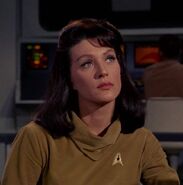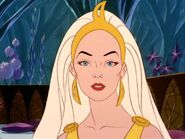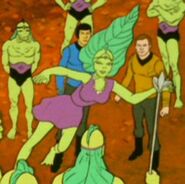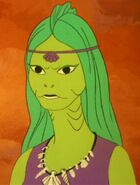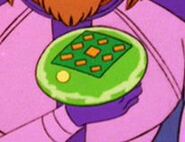Majel Barrett Roddenberry (23 February 1932 – 18 December 2008; age 76) was a recurring actress in the Star Trek franchise and was the wife of Star Trek creator Gene Roddenberry from 1969 until his death in 1991. This association with Roddenberry and his most famous creation has earned Barrett the title "The First Lady of Star Trek".
Barrett was the only performer to have had a role on the first six Star Trek series – usually not as a character but as the voice of the various computers used throughout those series. She also supplied the voice of the Enterprise computer in five of the Star Trek films – spanning all three film series (Original Series, The Next Generation Series, and the Alternate Reality Series)
Her most frequent portrayal in Star Trek, besides the computer, was that of Christine Chapel on Star Trek: The Original Series, Star Trek: The Animated Series, and in two of the films. She also voiced M'Ress and several other characters on The Animated Series and later played Betazoid Ambassador Lwaxana Troi on Star Trek: The Next Generation and Star Trek: Deep Space Nine. Her first filmed appearance was in the original Star Trek pilot episode "The Cage" as Number One in 1964.
Early life and career[]
Barrett was born Majel Leigh Hudec in Cleveland, Ohio. She enrolled in an acting workshop when she was ten years old but later attended the University of Miami in Coral Gables, Florida with the intention of becoming a legal clerk. She attended law school for a year, but, after failing a class in contract law, opted to move to New York to try her luck in acting. She landed parts in several stage plays, including Models by Season and The Solid Gold Cadillac, the latter of which toured across the country for nine months. During this time, her father, a police officer in Cleveland, was killed while out on patrol. [1]
Believing the competition in New York to be too stiff, Barrett moved to California in the 1950s where she won parts in stage plays as well as films. She had a bit part in the 1957 film Will Success Spoil Rock Hunter?, after which she made an uncredited appearance in the 1958 Paramount Pictures release The Black Orchid. She then landed a supporting role in the 1958 Paramount film As Young As We Were, along with Original Series guest actor Barry Atwater. She also had a brief role in Paramount's The Buccaneer that same year.
One of Barrett's earliest television appearances came in 1959 in an episode of the syndicated adventure/drama series Whirlybirds, which starred Kenneth Tobey. She then made an uncredited appearance as a waitress in a 1960 episode of Desilu's The Untouchables, which aired on NBC. That same year, she guest-starred on the ABC family comedy series Leave It to Beaver, which starred Tony Dow.
In 1961, Barrett was seen in a supporting role in Paramount Pictures' Love in a Goldfish Bowl. This was followed by a supporting role in the 1963 war drama The Quick and the Dead. She also continued making appearances on television shows, including Cain's Hundred (with Anthony Caruso) and a 1962 episode of Bonanza with her future Original Series co-star James Doohan, entitled "Gift of Water".
In 1962, Barrett met actress Lucille Ball at an acting class and was signed to a contract with Desilu. Soon thereafter, she appeared with Lucy in an episode of Desilu's The Lucy Show.
History with Gene Roddenberry and Star Trek[]
The 1960s[]
Barrett first met Gene Roddenberry in 1961. (Star Trek Memories, p. 14) In late 1963, she was cast in an episode of his Marine Corps drama, The Lieutenant, which starred Gary Lockwood. Incidentally, the episode in which Barrett appeared – titled "In the Highest Tradition" – also featured future Original Series regular Leonard Nimoy. In addition, the episode was directed by Marc Daniels, who later directed fifteen episodes of The Original Series.
Barrett's relationship with Roddenberry, who was married and had two children, developed into her becoming his mistress. She later remembered, "We weren't lovers at the very beginning, that sort of developed after we'd become friends." Barrett had doubts that Roddenberry was ready to end his marriage. "Up until Gene actually left his wife, I really couldn't anticipate spending my life with him," she explained. "I felt I would spend the rest of my life loving him, but not necessarily with him." (Star Trek Memories, p. 14)
In 1964, Roddenberry began developing "The Cage", which became the first of two pilots for Star Trek. Roddenberry selected Barrett to portray Number One, the first officer and helm officer of the Enterprise under Captain Christopher Pike (played by Jeffrey Hunter). The role was specifically written for Barrett from the start. (These Are the Voyages: TOS Season One) Barrett filmed her scenes between Monday 30 November 1964 and Thursday 3 December 1964, Tuesday 8 December 1964 and Wednesday 9 December 1964, and Wednesday 16 December 1964 and Thursday 17 December 1964 at Desilu Culver Stage 15 and 16.
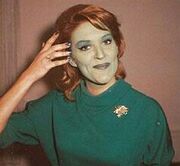
Barrett during early makeup tests
Barrett along with Leonard Nimoy had her first day for "The Cage" at the Desilu Culver Stage 15 on 17 November 1964. Barrett was present for the green color makeup tests for "The Cage", a task she completed for no monetary compensation. Of note, she was credited in this unaired pilot as "Majel Barrett", but was credited as "M. Leigh Hudec" for the same appearance in "The Menagerie" cut of the episode.
NBC ultimately rejected "The Cage," but they gave Roddenberry the chance to produce a second pilot. However, the network asked that he drop both the devilish-looking Spock (played by Leonard Nimoy) and Barrett's Number One character, asserting that audiences would never accept a woman being second-in-command of a ship. Roddenberry insisted on keeping Spock but agreed to drop Number One. Barrett jokingly stated that Roddenberry "kept the Vulcan and married the woman, 'cause he didn't think Leonard [Nimoy] would have it the other way around." [2]
In their book Inside Star Trek: The Real Story, Herb Solow and Robert H. Justman claimed that the account of NBC rejecting the female first officer was a myth created by Roddenberry. In their version, NBC was proud of gender and race diversity in its shows, and even insisted on having a strong female leading character, but they felt that Barrett was not a leading-type actress with strong screen presence suitable for playing such a role, nor did they like her being forced on them by Roddenberry. Apparently not wanting to hurt his mistress' pride, Roddenberry purportedly came up with this story in the 1970s-1980s Star Trek convention circuit, which he toured extensively with his by-then wife.
Although her character was dropped from the second pilot, "Where No Man Has Gone Before", after Star Trek was picked up as a series, Barrett, disguised as a blonde, was given the role of Nurse Christine Chapel in the episode "The Naked Time" by Roddenberry. Her appearance was surreptitiously introduced, according to Justman and Solow, because the network did not like her role in "The Cage". For this, Barrett donned a blond wig for her role, in a rather bold-faced effort of sneaking her back into the Star Trek production against the express wishes of NBC.
The ruse initially failed, and turned out to be one of the reasons for Lucille Ball, after she was informed of this, to ordain the firing of the pair of them on the spot, as a moral propriety-valuing Ball could not abide with nepotism. Concurrently, she had become aware that a married Roddenberry conducted an illicit affair with Barrett, which was an even stronger reason for her wanting them to be gone from her studio; Ball's own marriage with Desi Arnaz had fallen apart in no small part due to his philandering. It was Herb Solow who, through an intermediary, managed to convince Ball otherwise, though he had the toughest of times doing so. (Inside Star Trek: The Real Story, 1997, p. 223; These Are the Voyages: TOS Season One, 1st ed, pp. 25-27)
Ultimately, Barrett was allowed to return, and in total, was featured as Nurse Chapel in twenty-five of the seventy-nine episodes of Star Trek, from the first season's "The Naked Time" to the last episode of the series, "Turnabout Intruder". She also supplied the Computer Voice for the USS Enterprise in several episodes of the series.
Barrett filmed her scenes for "The Naked Time" between Thursday 30 June 1966 and Tuesday 5 July 1966 at Desilu Stage 9. She filmed her scenes for "What Are Little Girls Made Of?" between Thursday 28 July 1966 and Tuesday 9 August 1966 at Stage 9 and Stage 10, and her scenes for "Operation -- Annihilate!" between Friday 17 February 1967 and Wednesday 22 February 1967 at Stage 9.
She filmed her scenes for "Amok Time" between Friday 9 June 1967 and Tuesday 13 June 1967, her scenes for "The Changeling" on Wednesday 12 July 1967, her scenes for "The Deadly Years" on Thursday 3 August 1967, and between Monday 7 August 1967 and Friday 11 August 1967. She filmed her scenes for "Journey to Babel" on Wednesday 27 September 1967 and Thursday 28 September 1967, her scenes for "Obsession" on Friday 13 October 1967 and Monday 16 October 1967, her scenes for "The Immunity Syndrome" on Thursday 26 October 1967 and Wednesday 1 November 1967, and her scenes for "By Any Other Name" on Wednesday 15 November 1967. All of the above were filmed at Stage 9.
Barrett filmed her scenes for "Elaan of Troyius" on Thursday 6 June 1968 at Stage 9. She filmed her scenes for "The Paradise Syndrome" on Thursday 13 June 1968 on location at the Franklyn Reservoir. She filmed her scenes for "The Enterprise Incident" on Friday 21 June 1968, her scenes for "And the Children Shall Lead" on Thursday 27 June 1968, her scenes for "Spock's Brain" on Monday 8 July 1968, her scenes for "The Tholian Web" on Monday 7 August 1968 and Tuesday 8 August 1968, and her scenes for "For the World is Hollow and I Have Touched the Sky" on Wednesday 13 August 1968, all at Stage 9. She filmed her scenes for "Plato's Stepchildren" on Monday 16 September 1968 and Tuesday 17 September 1968 at Stage 10. She filmed her scenes for "Wink of an Eye" on Thursday 19 September 1968 and Friday 20 September 1968, her scenes for "Let That Be Your Last Battlefield" on Tuesday 8 October 1968 and Wednesday 9 October 1968, her scenes for "The Lights of Zetar" on Wednesday 6 November 1968, her scenes for "The Way to Eden" on Tuesday 26 November 1968, and her scenes for "Turnabout Intruder" between Tuesday 31 December 1968 and Friday 3 January 1969, all at Stage 9.
Marriage and continued collaboration[]
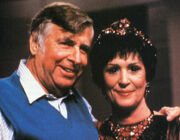
Majel and Gene
Barrett and Gene Roddenberry married on 6 August 1969, two months after the final episode of Star Trek was aired. Since they were both in Japan at the time, and because Roddenberry did not adhere to any particular religion, they decided to have a Shinto-Buddhist wedding. Roddenberry's divorce from Eileen Anita Rexroat had not yet been finalized, requiring the pair to make the marriage legal with a civil ceremony held on 29 December 1969. A brief filed with the California Court of Appeal on 30 September 1994, docket number B074848, by attorneys for Barrett confirms that Roddenberry's divorce was not final until December 24, 1969. [3] Their son, Eugene "Rod" Roddenberry, Jr., was born on 5 February 1974.
Barrett and Roddenberry continued working together throughout the 1970s. They both ran the catalog company Lincoln Enterprises, which they founded in 1967. In addition, Barrett acted in many of the unsold TV pilots Roddenberry wrote and produced, the first of which was Genesis II in 1973. In addition to Barrett, this project also featured performances by Star Trek alumni Ted Cassidy, Mariette Hartley, Harvey Jason, and Percy Rodriguez.
The following year, Barrett acted in Roddenberry's The Questor Tapes, which was directed by Richard Colla and which starred Robert Foxworth. That same year, Barrett performed in Roddenberry's Planet Earth, along with Diana Muldaur and the aforementioned Ted Cassidy. This project was directed by the aforementioned Marc Daniels. In 1977, Barrett appeared in one more Roddenberry pilot, entitled Spectre.
Post-TOS Trek work[]
Barrett voiced Nurse Chapel, as well as M'Ress and numerous other characters, on Star Trek: The Animated Series from 1973 through 1975. Barrett reprised her role of Christine Chapel, now a doctor, in 1979's Star Trek: The Motion Picture. She again played Doctor Chapel in 1986. Barrett then recurred Lwaxana Troi on Star Trek: The Next Generation and Star Trek: Deep Space Nine, appearing in six episodes of the former and three episodes of the latter. Barrett also co-wrote the story for the DS9 episode "The Muse", along with René Echevarria. For the episode "Half a Life", Barrett filmed her scenes between Wednesday 27 February 1991 and Friday 8 March 1991 on Paramount Stage 8 and 9. For the episode "Cost of Living", she filmed her scenes between Tuesday 4 February 1992 and Monday 10 February 1992 and Wednesday 12 February 1992 and Thursday 13 February 1992 on Paramount Stage 8, 9, and 16. Her makeup in this episode was applied by Michael Westmore. Barrett cited the TNG episode "Half a Life" as one of her favorite Star Trek episodes. (TNG Season 7 DVD special feature "Special Profiles Year Seven" ("From Comedy To Drama"))
In addition, Barrett voiced Starfleet computers in many episodes of TNG, DS9, and Star Trek: Voyager. As a result of providing the USS Defiant's computer voice in the Star Trek: Enterprise episode "In a Mirror, Darkly, Part II", she became the only actress to work on the first five live-action Star Trek television series. Along with Joseph Ruskin, Clint Howard, Jack Donner, and Vince Deadrick, she was one of only five actors to appear in both The Original Series and Enterprise.
She was also heard as the Enterprise computer voice in five of the feature films: Star Trek Generations, Star Trek: First Contact, Star Trek: Insurrection, Star Trek Nemesis, and Star Trek. She also voiced the Federation computer in the video games Star Trek: Judgment Rites, A Final Unity, Star Trek: Borg, and Star Trek Generations, in Star Trek: The Next Generation Interactive Technical Manual, in the television documentary To Boldly Go, and in the DVD-ROM editions of the Star Trek: The Next Generation Companion - A Series Guide and Script Library, the Star Trek: Deep Space Nine Companion - A Series Guide and Script Library, and the Star Trek Encyclopedia. She even voiced the ship's computer for the "World Enough and Time" episode of the fan-made internet series Star Trek: New Voyages, produced by James Cawley. Her son, Rod Roddenberry, was a consulting producer on this series at the time. She also voiced the ship's computer of the USS F. Scott Fitzgerald (NCC-85107-A) in the fan-made series Star Trek I: Specter produced by Brandon Bridge. (credits)
On 10 December 2008, it was announced that Barrett had again recorded a voiceover as the Enterprise computer for 2009's Star Trek. She had completed her voice work on the film sometime the previous week. The announcement that she was reprising her role as the computer voice came just eight days before her death. [4] [5] [6] [7]
Continuing the legacy[]
Barrett's association with the Star Trek franchise and her love affair with creator Gene Roddenberry has earned her the title "The First Lady of Star Trek." After Gene Roddenberry's death on 24 October 1991, Barrett became an integral part of Star Trek's continued legacy and that of Roddenberry himself. She continued to operate Lincoln Enterprises with their son, Rod, and attended at least one major Star Trek convention every year, in addition to making continued appearances and contributions to the Star Trek spin-offs.
Following Roddenberry's death, Barrett took material from his archives and used his ideas to develop two Canadian-produced science fiction television series. The first was Earth: Final Conflict, which ran from 1997 through 2002. The second was Andromeda, which aired from 2000 through 2005. Barrett served as executive producer on both of these shows until 2002 and had a recurring role as Julianne Belman on Earth: Final Conflict, but Roddenberry was credited as the creator of both shows, going as far as having the title logos for the programs proclaiming them as "Gene Roddenberry's Earth: Final Conflict" and "Gene Roddenberry's Andromeda".
Other acting credits[]
In addition to her commitment to Gene Roddenberry and to Star Trek, Barrett continued acting in unrelated projects. She made an uncredited appearance in the 1965 Paramount film Sylvia, which was followed by a major role in a 1966 musical film called Country Boy. In 1967, she had supporting roles in A Guide for the Married Man and Track of Thunder.
Barrett also continued appearing on television. She made a return visit to Bonanza in 1966, after which she appeared in such shows as The Second Hundred Years (which starred Monte Markham) and Here Come the Brides, starring Original Series guests Robert Brown, Mark Lenard, and David Soul.
Barrett portrayed Miss Carrie in Michael Crichton's 1973 science fiction classic Westworld. Alan Oppenheimer also had a role in this film. Barrett then appeared in Stanley Kramer's 1977 film The Domino Principle, playing the wife of a character played by Ted Gehring.
"Errand of Mercy" director John Newland directed Barrett in the 1979 made-for-TV movie The Suicide's Wife, which also starred Don Marshall. That same year, veteran Trek director Corey Allen directed Barrett in another TV movie, The Man in the Santa Claus Suit. In 1983, Barrett was briefly on the soap opera General Hospital.
Barrett appeared in two 1995 independent films: Mommy and Teresa's Tattoo. The latter film also featured one-time TNG guest actor Diedrich Bader.
In 1996, Barrett guest-starred as the widow of the Centauri emperor in the episode of the cult science fiction series Babylon 5 entitled "Point of No Return". She took the role as a goodwill gesture in hopes of calming the rivalry between the Trek franchise and the burgeoning new competitor. [8] In addition to series regular Andreas Katsulas, the episode also featured Vaughn Armstrong and Marshall R. Teague. From 1996 through 1998, Barrett voiced Anna Watson, the aunt of Mary Jane Watson, in the animated Spider-Man series based on the Marvel Comics characters. In 1998, Barrett, along with her Star Trek co-stars Walter Koenig, George Takei, and Grace Lee Whitney and Trek alumni Bill Mumy and Wil Wheaton, made gag appearances in the episode of Diagnosis Murder called "Alienated."
As an in-joke, Barrett was brought in by Trekkie writer and producer Seth MacFarlane to participate on his animated series, Family Guy. In the episode called "Emission Impossible," Barrett supplied the voice of Stewie's "sperm" ship, a nod to her four-decade role as a computer voice on Star Trek. The episode also featured the voice of DS9 alumnus Wallace Shawn.
Death[]
Barrett died at her home in Bel Air, California, at 12:27 am on 18 December 2008 following a short battle with leukemia. She was surrounded by family, friends and her son, Eugene "Rod" Roddenberry, Jr. She was 76 years old. [9]
Trust[]
The trust documents obtained after Barrett's death disclosed that her pet dogs were left a US$4 million trust and the rights to live in one of her mansions until they die. Barrett's employee, Reinelda Estupinian, was left US$1 million and the right to live and care for the pets in the same house. Son Eugene was left the family's Bel Air mansion, US$60 million and US$10 million bonuses when he turns 35, 40, and 45. [10]
Star Trek appearances[]
Appearances as Christine Chapel[]
- TOS:
- "The Naked Time"
- "What Are Little Girls Made Of?"
- "Operation -- Annihilate!"
- "Amok Time"
- "The Changeling"
- "Journey to Babel"
- "The Deadly Years"
- "Obsession"
- "The Immunity Syndrome"
- "A Private Little War"
- "Return to Tomorrow"
- "By Any Other Name"
- "Spock's Brain"
- "The Enterprise Incident"
- "The Paradise Syndrome"
- "And the Children Shall Lead"
- "For the World is Hollow and I Have Touched the Sky"
- "The Tholian Web"
- "Plato's Stepchildren"
- "Wink of an Eye"
- "Elaan of Troyius"
- "Let That Be Your Last Battlefield"
- "The Lights of Zetar"
- "The Way to Eden"
- "Turnabout Intruder"
- TAS:
- Star Trek films
| Star Trek: The Original Series regular cast |
|---|
| Starring: William Shatner • Leonard Nimoy • DeForest Kelley |
| Co-Starring: Majel Barrett • James Doohan • Walter Koenig • Nichelle Nichols • George Takei • Grace Lee Whitney |
| Star Trek: The Animated Series regular cast |
|---|
| Starring: William Shatner • Leonard Nimoy • DeForest Kelley |
| Co-Starring: Majel Barrett • James Doohan • Nichelle Nichols • George Takei |
Federation computer voice[]
- Currently incomplete...
- TOS:
- "Mudd's Women" as USS Enterprise Computer (uncredited)
- "The Conscience of the King" as Enterprise computer voice (uncredited)
- "The Galileo Seven" as Enterprise computer voice (uncredited)
- "Court Martial" as Starbase 11 recorder voice and Enterprise computer voice (uncredited)
- "The Menagerie, Part I" as Enterprise computer voice (uncredited)
- "Tomorrow is Yesterday" as Enterprise computer voice (uncredited)
- "A Taste of Armageddon" as Enterprise computer voice (uncredited)
- "Wolf in the Fold" as Enterprise computer voice (uncredited)
- "The Deadly Years" as Enterprise computer voice (uncredited)
- "The Tholian Web" as Enterprise computer voice (uncredited)
- "Day of the Dove" as Enterprise computer voice (uncredited)
- "Wink of an Eye" as Enterprise computer voice (uncredited)
- "That Which Survives" as Enterprise computer voice (uncredited)
- "Let That Be Your Last Battlefield" as Enterprise computer voice (uncredited)
- "The Lights of Zetar" as Enterprise computer voice (uncredited)
- TAS:
- "The Lorelei Signal" as Enterprise computer voice
- "The Survivor" as Enterprise computer voice
- "The Infinite Vulcan" as Enterprise computer voice
- "The Pirates of Orion" as Enterprise computer voice
- "The Practical Joker" as Enterprise computer voice
- TNG:
- "11001001" as USS Enterprise-D computer voice (uncredited)
- "Home Soil" as Enterprise-D computer voice (uncredited)
- "Skin Of Evil" as Enterprise-D computer voice (uncredited)
- "We'll Always Have Paris" as Enterprise-D computer voice (uncredited)
- "Conspiracy" as Enterprise-D computer voice (uncredited)
- "The Neutral Zone" as Enterprise-D computer voice (uncredited)
- "The Child" as Enterprise-D computer voice (uncredited)
- "Where Silence Has Lease" as Enterprise-D computer voice (uncredited)
- "Elementary, Dear Data" as Enterprise-D computer voice (uncredited)
- "The Outrageous Okona" as Enterprise-D computer voice (uncredited)
- "The Schizoid Man" as Enterprise-D computer voice (uncredited)
- "Unnatural Selection" as Enterprise-D computer voice (uncredited)
- "The Measure Of A Man" as Enterprise-D computer voice (uncredited)
- "Contagion" as Enterprise-D computer voice (uncredited)
- "The Royale" as Enterprise-D computer voice (uncredited)
- "The Icarus Factor" as Enterprise-D computer voice (uncredited)
- "Pen Pals" as Enterprise-D computer voice (uncredited)
- "Q Who" as Enterprise-D computer voice (uncredited)
- "Samaritan Snare" as Enterprise-D computer voice (uncredited)
- "Up The Long Ladder" as Enterprise-D computer voice (uncredited)
- "Manhunt" as Enterprise-D computer voice (uncredited)
- "The Emissary" as Enterprise-D computer voice (uncredited)
- "Evolution" as Enterprise-D computer voice (uncredited)
- "Booby Trap" as Enterprise-D computer voice (uncredited)
- "The Price" as Enterprise-D computer voice (uncredited)
- "The Vengeance Factor" as Enterprise-D computer voice (uncredited)
- "The Defector" as Enterprise-D computer voice (uncredited)
- "The Hunted" as Enterprise-D computer voice (uncredited)
- "Deja Q" as Enterprise-D computer voice (uncredited)
- "A Matter of Perspective" as Enterprise-D computer voice (uncredited)
- "Yesterday's Enterprise" as Enterprise-D computer voice (uncredited)
- "Sins of The Father" as Enterprise-D computer voice (uncredited)
- "Tin Man" as Enterprise-D computer voice (uncredited)
- "Hollow Pursuits" as Enterprise-D computer voice (uncredited)
- "The Most Toys" as Enterprise-D computer voice (uncredited)
- "Transfigurations" as Enterprise-D computer voice (uncredited)
- "The Best of Both Worlds" as Enterprise-D computer voice (uncredited)
- "The Best of Both Worlds, Part II" as Enterprise-D computer voice (uncredited)
- "Suddenly Human" as Enterprise-D computer voice (uncredited)
- "Brothers" as Enterprise-D computer voice (uncredited)
- "Family" as Enterprise-D computer voice (uncredited)
- "Remember Me" as Enterprise-D computer voice (uncredited)
- "Reunion" as Enterprise-D computer voice (uncredited)
- "Future Imperfect" as Enterprise-D computer voice (uncredited)
- "Final Mission" as Enterprise-D computer voice (uncredited)
- "The Loss" as Enterprise-D computer voice (uncredited)
- "Data's Day" as Enterprise-D computer voice (uncredited)
- "The Wounded" as Enterprise-D computer voice (uncredited)
- "Clues" as Enterprise-D computer voice (uncredited)
- "Galaxy's Child" as Enterprise-D computer voice (uncredited)
- "Identity Crisis" as Enterprise-D computer voice (uncredited)
- "The Nth Degree" as Enterprise-D computer voice (uncredited)
- "Qpid" as Enterprise-D computer voice (uncredited)
- "The Host" as Enterprise-D computer voice (uncredited)
- "The Mind's Eye" as Enterprise-D & Onizuka computer voice
- "In Theory" as Enterprise-D computer voice
- "Redemption" as Enterprise-D computer voice
- "Darmok" as Enterprise-D computer voice
- "Ensign Ro" as Enterprise-D computer voice
- "The Game" as Enterprise-D computer voice
- "Unification I" as Enterprise-D computer voice
- "New Ground" as Enterprise-D computer voice
- "Violations" as Enterprise-D computer voice
- "Conundrum" as Enterprise-D computer voice
- "Power Play" as Enterprise-D computer voice
- "Cost Of Living" as Enterprise-D computer voice
- "The Perfect Mate" as Enterprise-D computer voice
- "Time's Arrow, Part II" as Enterprise-D computer voice
- "Realm Of Fear" as Enterprise-D computer voice
- "Man Of The People" as Enterprise-D computer voice
- "Relics" as Enterprise-D computer voice
- "Schisms" as Enterprise-D computer voice
- "Rascals" as Enterprise-D and Fermi computer voice
- "A Fistful of Datas" as Enterprise-D computer voice
- "The Quality of Life" as Enterprise-D computer voice
- "Chain Of Command, Part I" as Enterprise-D computer voice
- "Chain Of Command, Part II" as Enterprise-D computer voice
- "Ship In A Bottle" as Enterprise-D computer voice
- "Aquiel" as Relay Station 47 computer voice / Enterprise-D computer voice
- "Face Of The Enemy" as Enterprise-D computer voice (credited but in a deleted scene)
- "Tapestry" as Starbase Earhart computer voice
- "Starship Mine" as Enterprise-D computer voice
- "Lessons" as Enterprise-D computer voice
- "The Chase" as Enterprise-D computer voice
- "Suspicions" as Enterprise-D and Justman computer voice
- "Rightful Heir" as Enterprise-D computer voice
- "Timescape" as Enterprise-D and Runabout computer voice (uncredited)
- "Descent" as Enterprise-D computer voice (uncredited)
- "Force of Nature" as Enterprise-D computer voice
- "Parallels" as Enterprise-D computer voice
- "Homeward" as Enterprise-D computer voice
- "Thine Own Self" as Enterprise-D computer voice
- "Eye of the Beholder" as Enterprise-D computer voice
- "Genesis" as Enterprise-D computer voice
- "Firstborn" as Enterprise-D computer voice
- "Bloodlines" as Enterprise-D computer voice
- "All Good Things..." as Enterprise-D computer voice
- DS9:
- "Emissary" as USS Saratoga's computer voice
- "Babel" as runabout computer voice (uncredited)
- "The Passenger" as USS Rio Grande computer voice (uncredited)
- "Vortex" as USS Ganges computer voice
- "Battle Lines" as USS Rio Grande computer voice
- "Melora" as USS Orinoco computer voice (uncredited)
- "Whispers"
- "Paradise"
- "Playing God"
- "Tribunal"
- "The Jem'Hadar"
- "The Search, Part II" as USS Defiant computer voice
- "Defiant" as USS Defiant computer voice/Federation computer voice
- "Fascination"
- "Heart of Stone"
- "Facets"
- "The Adversary" as USS Defiant computer voice
- "The Visitor" as USS Defiant computer voice
- "The Assignment"
- "Blaze of Glory"
- "Valiant" as USS Valiant computer voice
- "Penumbra" as USS Gander computer voice
- "The Dogs of War" as Federation computer voice
- VOY:
- "Caretaker" as the USS Voyager computer voice
- "Phage" as the USS Voyager computer voice
- "State of Flux" as the USS Voyager computer voice
- "Heroes and Demons" as the USS Voyager computer voice
- "Cathexis" as the USS Voyager computer voice
- "Jetrel" as the USS Voyager computer voice
- "Learning Curve" as the USS Voyager computer voice
- "Projections" as the USS Voyager computer voice
- "Initiations" as type 8 shuttlecraft computer voice
- "Non Sequitur" as Starfleet Headquarters and USS Yellowstone computer voice
- "Parturition" as type 8 shuttlecraft computer voice
- "Persistence of Vision" as USS Voyager computer voice
- "Tattoo" as the USS Voyager computer voice
- "Maneuvers" as the USS Voyager computer voice
- "Threshold" as the USS Voyager computer voice
- "Meld" as the USS Voyager computer voice
- "Dreadnought" as the USS Voyager computer voice
- "Investigations" as the USS Voyager computer voice
- "Deadlock" as the USS Voyager computer voice
- "Basics, Part I" as the USS Voyager computer voice
- "Basics, Part II" as the USS Voyager computer voice
- "The Swarm" as the USS Voyager computer voice
- "Remember" as the USS Voyager computer voice
- "Future's End, Part II" as the USS Voyager computer voice
- "Warlord" as the USS Voyager computer voice
- "Alter Ego" as the USS Voyager computer voice
- "Coda" as the USS Voyager computer voice
- "Darkling" as the USS Voyager computer voice
- "Distant Origin" as the USS Voyager computer voice
- "Displaced" as the USS Voyager computer voice
- "Worst Case Scenario" as the USS Voyager computer voice
- "Day of Honor" as Cochrane and EV suit computer voice
- "The Raven" as Cochrane computer voice
- "Year of Hell" as the USS Voyager computer voice
- "Concerning Flight" as the USS Voyager computer voice
- "Message in a Bottle" as the USS Voyager computer voice/ USS Prometheus computer voice
- "Waking Moments" as the USS Voyager computer voice
- "The Killing Game, Part II" as the USS Voyager computer voice (credit only)
- "Vis à Vis" as the USS Voyager computer voice
- "The Omega Directive" as the USS Voyager computer voice
- "Demon" as the USS Voyager computer voice
- "One" as the USS Voyager computer voice
- "Hope and Fear" as the USS Voyager computer voice/ USS Dauntless computer voice
- "Drone" as the USS Voyager computer voice
- "Extreme Risk" as the USS Voyager computer voice
- "Once Upon a Time" as the USS Voyager computer voice
- "Nothing Human" as the USS Voyager computer voice
- "Timeless" as the USS Voyager computer voice
- "Thirty Days" as the USS Voyager computer voice
- "Infinite Regress" as the USS Voyager computer voice
- "Counterpoint" as the USS Voyager computer voice
- "Latent Image" as the USS Voyager computer voice
- "Bride of Chaotica!" as the USS Voyager computer voice
- "The Fight" as the USS Voyager computer voice
- "Bliss" as the USS Voyager computer voice
- "The Disease" as the USS Voyager computer voice
- "Dark Frontier" as the USS Voyager computer voice
- "Course: Oblivion" as the USS Voyager computer voice
- "Juggernaut" as the USS Voyager computer voice
- "11:59" as the USS Voyager computer voice
- "Equinox" as the USS Voyager/USS Equinox computer voice
- "Equinox, Part II" as the USS Voyager/USS Equinox computer voice
- "Survival Instinct" as the USS Voyager computer voice
- "Tinker Tenor Doctor Spy" as the USS Voyager computer voice
- "Dragon's Teeth" as the USS Voyager computer voice
- "One Small Step" as the USS Voyager computer voice
- "The Voyager Conspiracy" as the USS Voyager computer voice
- "Pathfinder" as the USS Voyager computer voice
- "Fair Haven" as the USS Voyager computer voice
- "Collective" as the USS Voyager computer voice
- "Spirit Folk" as the USS Voyager computer voice
- "Ashes to Ashes" as the USS Voyager computer voice
- "Child's Play" as the USS Voyager computer voice
- "Good Shepherd" as the USS Voyager computer voice
- "Fury" as the USS Voyager computer voice
- "Muse" as Delta Flyer computer voice
- "Life Line" as the USS Voyager computer voice
- "The Haunting of Deck Twelve" as the USS Voyager computer voice
- "Imperfection" as the USS Voyager computer voice
- "Drive" as Delta Flyer computer voice
- "Repression" as the USS Voyager computer voice
- "Inside Man" as Communications Research Center computer voice / USS Voyager computer voice
- "Flesh and Blood" as the USS Voyager computer voice
- "Body and Soul" as the USS Voyager computer voice
- "Shattered" as the USS Voyager computer voice
- "Lineage" as the USS Voyager computer voice
- "Prophecy" as the USS Voyager computer voice
- "Workforce" as the USS Voyager computer voice
- "Workforce, Part II" as Narrator
- "Human Error" as the USS Voyager computer voice
- "Q2" as USS Voyager computer voice
- "Author, Author" as the USS Voyager computer voice
- "Natural Law" as class 2 shuttle computer voice
- "Homestead" as Delta Flyer computer voice
- "Renaissance Man" as the USS Voyager computer voice
- "Endgame" as the SC-4/ USS Voyager/ Communications Research Center computer voice
- ENT:
- "In a Mirror, Darkly, Part II" as USS Defiant (NCC-1764)'s computer voice
- "These Are the Voyages..." as USS Enterprise-D computer voice
- Star Trek films
- Star Trek Generations as USS Enterprise-D computer voice
- Star Trek: First Contact as USS Enterprise-E's computer voice
- Star Trek: Insurrection as USS Enterprise-E computer voice
- Star Trek Nemesis as USS Enterprise-E computer voice (credited as "Majel Barrett Roddenberry")
- Star Trek as Enterprise computer voice (credited as "Majel Barrett Roddenberry")
- PIC:
- "Võx" as Enterprise-D computer voice (archive audio)
- "The Last Generation" as Enterprise-D computer voice (archive audio)
Appearances as Lwaxana Troi[]
- TNG:
- "Haven"
- "Manhunt"
- "Ménage à Troi"
- "Half a Life"
- "Cost Of Living"
- "Dark Page"
- DS9:
- "The Forsaken"
- "Fascination"
- "The Muse"
Narrator[]
- TNG:
- "The Best of Both Worlds, Part II" (uncredited)
- "Redemption II" (uncredited)
- "Unification II" (uncredited)
- "Time's Arrow, Part II" (uncredited)
- "Chain Of Command, Part II" (uncredited)
- "Birthright, Part II" (uncredited)
- "Descent, Part II" (uncredited)
- "Gambit, Part II" (uncredited)
- DS9:
- "The Circle" (uncredited)
- "The Maquis, Part II" (uncredited)
- "The Search, Part I" (uncredited)
- "Past Tense, Part II" (uncredited)
- "A Time to Stand" (uncredited)
- "Sacrifice of Angels" (uncredited)
- "Image in the Sand" (uncredited)
- "Shadows and Symbols" (uncredited)
- "'Til Death Do Us Part" (uncredited)
- "Strange Bedfellows" (uncredited)
- VOY:
- "Caretaker" (uncredited)
- "Cold Fire" (uncredited)
- "Scorpion"
- "Scorpion, Part II"
- "Year of Hell, Part II"
- "The Killing Game, Part II"
- "Unimatrix Zero, Part II"
Writing credit[]
Star Trek interviews[]
- Launch of Star Trek: Voyager – Host (1995)
- TNG Season 5 DVD special feature "A Tribute to Gene Roddenberry" ("Gene Roddenberry Building Dedicated to Star Trek's Creator", "Gene's Final Voyage"), interviewed on 4 February 2002
- TNG Season 7 DVD special feature "Special Profiles Year Seven" ("Lwaxana Troi", "From Comedy To Drama"), interviewed on 4 February 2002
- The Official Star Trek: The Next Generation Magazine issue 2, pp. 18-20, "Majel Barrett – Lwaxana Troi", interviewed by Bill Florence
External links[]
- Majel Barrett's biography(X) at Roddenberry.com(X)
- Majel Barrett Roddenberry at the Internet Movie Database
- Majel Barrett Roddenberry at the Notable Names Database
- Majel Barrett Roddenberry at the Earth: Final Conflict Wiki
- Majel Barrett at Wikipedia
- Majel Barrett Roddenberry at TriviaTribute.com
- Obituary by Ian Spelling at SciFi.com
- Obituary at Legacy.com

